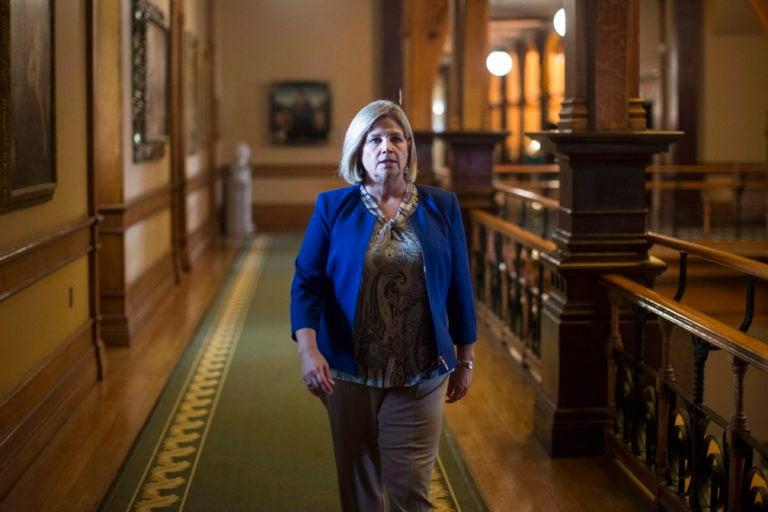Ontarians won’t tolerate any more tinkering with long-term care
Andrea Horwath: What we are witnessing is nothing less than a fundamental failure of Canada’s governments, private companies and institutions to ensure seniors’ health and safety, which borders on elderly abuse

NDP Leader Andrea Horwath walks back to her office, following Question Period at the Ontario Legislature in Toronto on Aug. 1, 2018. (Chris Young/CP)
Share
Andrea Horwath is Leader of Ontario’s New Democrats. She represents the riding of Hamilton Centre, and served on Hamilton’s City Council before being elected to Queen’s Park.
Canadians believe in taking care of one another. The COVID-19 pandemic has put that on display, from health care workers at patients’ bedsides, to grocery store staff braving each day, to kids decorating their windows with encouraging messages for neighbours. Even apart, we’re still working together as a community.
But despite our solidarity, it feels like there are two separate COVID-19 pandemics in Ontario. The one that’s slowly making progress, and the one tearing through long-term care, with no sign of slowing down.
By May 4 in Ontario, about 970 of the 1,300 COVID-19 deaths were long-term care residents. There are lives yet to be saved, but we’ll never look back and believe we won this battle. We’ve already lost too much.
MORE:Fear and exhaustion: Working as a PSW in long-term care during the coronavirus
Major cracks in long-term care were visible long before this started: seniors were hospitalized for dehydration and malnourishment because their care home didn’t have enough staff to help them eat and drink; residents who were in their beds for days and developed horrifying bed sores, were ignored; frontline workers pleaded with the government for more staff, more support and more funding. And family members didn’t hear regularly from care facilities, right up until they had to ask, how did mom break her hip? How did she fall? Why was she alone?
In the late 1990s, Premier Mike Harris opened the floodgates for private, for-profit long-term care homes to operate in Ontario, and with minimal regulation in place, many companies saw a cash cow—a way to cut corners and pocket the difference. The cracks in long-term care widened through the 2000s, culminating in the horrifying Wettlaufer case, where a nurse murdered eight seniors and attempted to murder six more between 2007 and 2016.
Shamefully, instead of expanding the Wettlaufer inquiry to finally address the province-wide crisis in seniors care, Ontario’s then-Liberal government chose to compartmentalize, block the broad public inquiry, and sweep these problems under the rug. They even cancelled annual inspections of long-term care facilities, before being publicly shamed into restoring the practice. But that didn’t last.
MORE: Trudeau’s daily coronavirus update: Military to provide support for long-term care facilities
Over the last year, the Ford government has conducted nine comprehensive inspections in Ontario’s 626 long-term care homes. Now, in any given community, one can find care homes a few blocks apart with drastically different protocols, standards of care and reputations.
The frontline health care workers and personal support workers we’ve rightly lionized as heroes of the pandemic–folks who are predominantly women, and especially women of colour–are paid minimum wage or slightly more. And because for-profit homes find it cheaper to employ many part-time workers instead of one full-time worker, these people often have to cobble together multiple part-time jobs without a pension, health benefits or paid sick days.
The status quo of seniors care over the past three decades, culminating in the response to COVID-19, has been an unmitigated failure, causing unconscionable amounts of unnecessary pain, suffering and death. What we are witnessing is nothing less than a fundamental failure of Canada’s governments, private companies and institutions to ensure seniors’ health and safety, which borders on elderly abuse.
This isn’t who we are, and it’s not the best we can do.
First, we have to address the pandemic by adopting urgent measures to stamp out COVID-19 hotspots. This includes developing criteria for when public health must step in and take over unsafe facilities. It means giving every worker personal protective equipment, including N95 masks, and it means mandating infection control, isolation and minimum staffing requirements in each home, on each shift.
When the dust settles after this disaster, we must never go back to how things were. Ontarians won’t tolerate any more tinkering with long-term care. We need a complete overhaul. This starts with a comprehensive public inquiry into long-term care, creating a long-term care residents’ bill of rights, restoring a legislated minimum standard of care for every resident, and funding care homes so they can meet it.
We also need to make a conscious policy decision about who should own and operate long-term care residences. I envision a public, community-based non-profit seniors care system; one that doesn’t siphon away frontline funding to pad the pockets of multi-national corporations, but instead uses every penny to deliver the best care.
I envision a future where health care workers are paid a living wage, with benefits and a pension that reflect their worth, and I want enough of them on each shift, so they can take time to interact with residents and deliver excellent care. I also envision culturally sensitive care rooted in strong, close-knit, engaged communities, where residents can communicate in their mother tongue—be it Mandarin, Punjabi, Finnish or Oji-Cree. I want inspections, regulations and high standards baked in, without shareholders and lobbyists constantly resisting them.